Sir Alfred James Munnings, PRA, RWS (British, 1878-1959)The old gravel pit, Swainsthorpe
signed and dated 'A.J.Munnings/1907.' (lower left)
oil on canvas
76.2 x 127cm (30 x 50in).FootnotesProvenance
The Revd. & Mrs. Thomas Page-Phillips.
Inherited circa 1962 by Captain W. E. B. Godsal, R.N.
Anon. sale, Sotheby's, London, 21 June 1995, lot 28.
With Richard Green, London.
Private collection, UK.
Exhibited
London, Royal Academy, 1908, no. 556.
Exhibited
The Munnings Museum, Dedham, 1974-1979.
Literature
Sir Alfred Munnings, An Artist's Life - Autobiography, Museum Press, London, 1950, vol. 1, pp.197-198, and p. 236.
Jean Goodman, What a Go!: The Life of Sir Alfred Munnings, London, 1988, p.84.
The Shadows of the pit were warm and glowing; the gravel bright red and gold in the sun; scarlet poppies, marguerite daisies and masses of white flowers all about.
The present work is one of Munnings' most iconic paintings of his early period. Although his talent had been recognized very early on, he had not yet acquired national recognition or the status of society painter that came after the First World War. Without demands of patrons, he was free to choose his own compositions and themes, experimenting with light and colour effects under natural light conditions, previously pioneered by the Impressionists. As part of the art world, he was obviously familiar with Impressionistic practices and colour theories and saw many examples first hand in 1905, at the Grafton Galleries' exhibition of three hundred and fifteen Impressionist paintings in London. This included significant works by Degas, Manet, Renoir and Pissarro, to name a few.
During the early years of the century, Munnings created a series of pictures of various ponies grazing in gravel or sand pits. Although the works all depict equine figures, the real subject of these pictures was the light effects as the sun beat down from above and shimmers off the sandy walls of the pits. The walls of the pits capture heat and change the atmosphere surrounding the figures. Equine figures in these works and in this particular painting were used as surfaces off which the kaleidoscope of light and colour could be reflected.
In the present lot, reflected light is evident throughout the pony's coat. Yellow and peach tones reflect off the red clay soil forming the darker shadows while the bluey-mauve from the sky creates the contours of the pony's body. Highlights in one area are shadows in others. Munnings has used 'live colours'- yellow and orange, perhaps a little scarlet and green which 'must be placed with a fine, harmonious precision, or the whole atmospheric balance of the picture will be upset.'1 By painting in the open air, Munnings could always achieve the harmonious relativity of all the elements. By maintaining this balance, his subjects blend naturally into their surroundings. The present work, so obviously painted en plein air, is a particularly good example of this cohesion.
The spot where the present lot was painted, 'in the pit by the farm buildings over the road' from his family's mill in Mendham, and another near his home at Church Farm, Swainsthorpe, formed the backdrop for the series of works that Munnings painted between 1907-1911. Munnings recalls working in 'a sandpit at this farm in Arcadia' in fine September weather, following a 'not too fine' summer: 'I faced the sun, which was slightly to the right. Thank God for the afternoon sunlight casting longer shadows! The Shadows of the pit were warm and glowing; the gravel bright red and gold in the sun; scarlet poppies, marguerite daisies and masses of white flowers all about. The white pony, tied to a long line, with a blaze of light on his back, in the centre, and others grazing near. Cast shadows made the design.'
This white pony with curly mane and docked tail was Munnings' most famous model and equine friend, Augereau, who first began to appear in paintings in 1907. As Munnings noted, 'Augereau was the most picturesque of white ponies- an artist's ideal. A white horse has been used in many pictures by many artists. Augereau's name may go down to posterity as the last of his disappearing race to pose as a model for a picture.'
The painting received positive attention from other artists when it was hung at the Royal Academy in 1908- 'I found it on Varnishing Day with a small gathering of artists round it...There stood Augereau in warmth and sunlight. What a pony!'2 -and was purchased on Private Viewing Day for £150, the highest price the artist had received to date.
1 A. J. Munnings, RA, Pictures of Horses and English Life, London, 1939 pp. 17-18.
2 Sir Alfred Munnings, An Artist's Life - Autobiography, Museum Press, London, 1950, passim.
We are grateful to Lorian Peralta-Ramos for her assistance in preparing this catalogue entry.
Sir Alfred James Munnings, PRA, RWS (British, 1878-1959)The old gravel pit, Swainsthorpe
signed and dated 'A.J.Munnings/1907.' (lower left)
oil on canvas
76.2 x 127cm (30 x 50in).FootnotesProvenance
The Revd. & Mrs. Thomas Page-Phillips.
Inherited circa 1962 by Captain W. E. B. Godsal, R.N.
Anon. sale, Sotheby's, London, 21 June 1995, lot 28.
With Richard Green, London.
Private collection, UK.
Exhibited
London, Royal Academy, 1908, no. 556.
Exhibited
The Munnings Museum, Dedham, 1974-1979.
Literature
Sir Alfred Munnings, An Artist's Life - Autobiography, Museum Press, London, 1950, vol. 1, pp.197-198, and p. 236.
Jean Goodman, What a Go!: The Life of Sir Alfred Munnings, London, 1988, p.84.
The Shadows of the pit were warm and glowing; the gravel bright red and gold in the sun; scarlet poppies, marguerite daisies and masses of white flowers all about.
The present work is one of Munnings' most iconic paintings of his early period. Although his talent had been recognized very early on, he had not yet acquired national recognition or the status of society painter that came after the First World War. Without demands of patrons, he was free to choose his own compositions and themes, experimenting with light and colour effects under natural light conditions, previously pioneered by the Impressionists. As part of the art world, he was obviously familiar with Impressionistic practices and colour theories and saw many examples first hand in 1905, at the Grafton Galleries' exhibition of three hundred and fifteen Impressionist paintings in London. This included significant works by Degas, Manet, Renoir and Pissarro, to name a few.
During the early years of the century, Munnings created a series of pictures of various ponies grazing in gravel or sand pits. Although the works all depict equine figures, the real subject of these pictures was the light effects as the sun beat down from above and shimmers off the sandy walls of the pits. The walls of the pits capture heat and change the atmosphere surrounding the figures. Equine figures in these works and in this particular painting were used as surfaces off which the kaleidoscope of light and colour could be reflected.
In the present lot, reflected light is evident throughout the pony's coat. Yellow and peach tones reflect off the red clay soil forming the darker shadows while the bluey-mauve from the sky creates the contours of the pony's body. Highlights in one area are shadows in others. Munnings has used 'live colours'- yellow and orange, perhaps a little scarlet and green which 'must be placed with a fine, harmonious precision, or the whole atmospheric balance of the picture will be upset.'1 By painting in the open air, Munnings could always achieve the harmonious relativity of all the elements. By maintaining this balance, his subjects blend naturally into their surroundings. The present work, so obviously painted en plein air, is a particularly good example of this cohesion.
The spot where the present lot was painted, 'in the pit by the farm buildings over the road' from his family's mill in Mendham, and another near his home at Church Farm, Swainsthorpe, formed the backdrop for the series of works that Munnings painted between 1907-1911. Munnings recalls working in 'a sandpit at this farm in Arcadia' in fine September weather, following a 'not too fine' summer: 'I faced the sun, which was slightly to the right. Thank God for the afternoon sunlight casting longer shadows! The Shadows of the pit were warm and glowing; the gravel bright red and gold in the sun; scarlet poppies, marguerite daisies and masses of white flowers all about. The white pony, tied to a long line, with a blaze of light on his back, in the centre, and others grazing near. Cast shadows made the design.'
This white pony with curly mane and docked tail was Munnings' most famous model and equine friend, Augereau, who first began to appear in paintings in 1907. As Munnings noted, 'Augereau was the most picturesque of white ponies- an artist's ideal. A white horse has been used in many pictures by many artists. Augereau's name may go down to posterity as the last of his disappearing race to pose as a model for a picture.'
The painting received positive attention from other artists when it was hung at the Royal Academy in 1908- 'I found it on Varnishing Day with a small gathering of artists round it...There stood Augereau in warmth and sunlight. What a pony!'2 -and was purchased on Private Viewing Day for £150, the highest price the artist had received to date.
1 A. J. Munnings, RA, Pictures of Horses and English Life, London, 1939 pp. 17-18.
2 Sir Alfred Munnings, An Artist's Life - Autobiography, Museum Press, London, 1950, passim.
We are grateful to Lorian Peralta-Ramos for her assistance in preparing this catalogue entry.
.jpg)
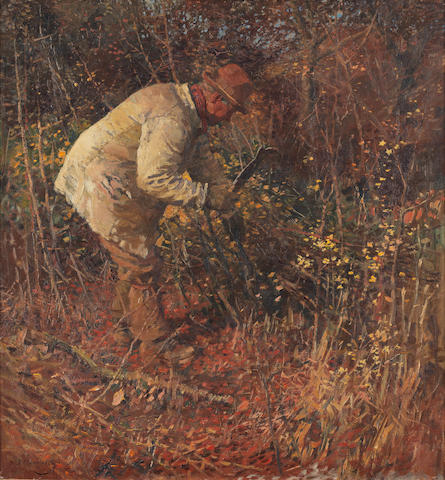

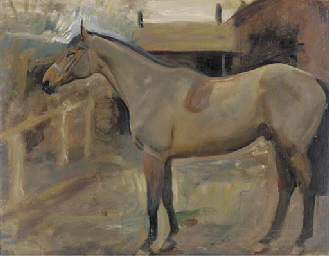
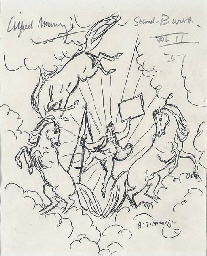
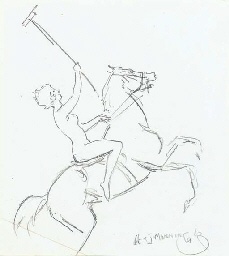
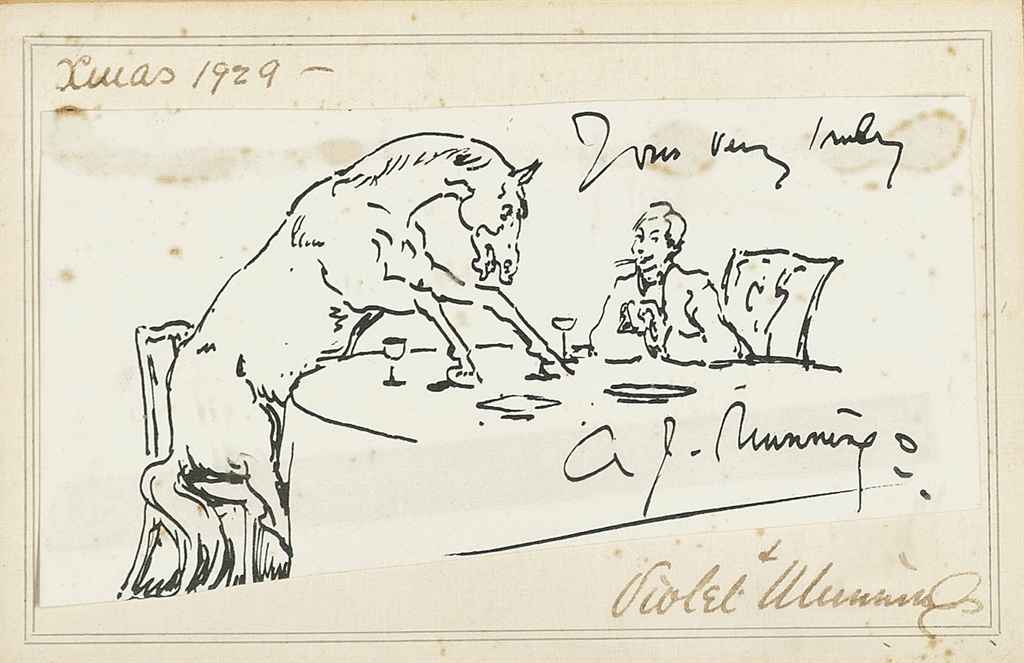

.jpg)

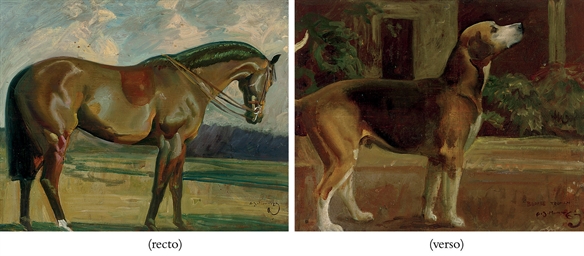
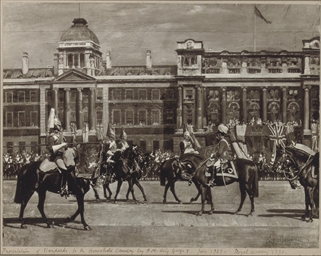
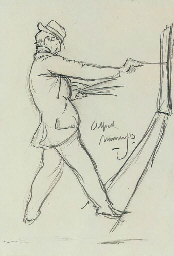
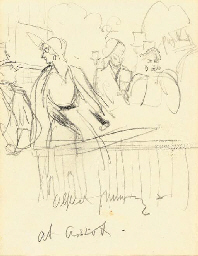
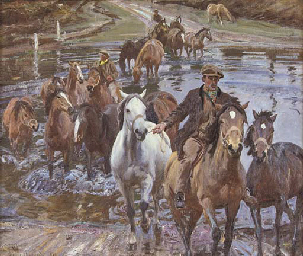
Testen Sie LotSearch und seine Premium-Features 7 Tage - ohne Kosten!
Lassen Sie sich automatisch über neue Objekte in kommenden Auktionen benachrichtigen.
Suchauftrag anlegen